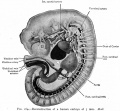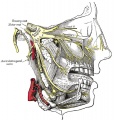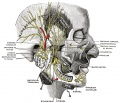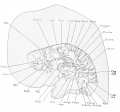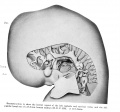Neural - Cranial Nerve Development: Difference between revisions
mNo edit summary |
mNo edit summary |
||
| Line 38: | Line 38: | ||
|-bgcolor="F5FAFF" | |-bgcolor="F5FAFF" | ||
| | | | ||
* '''Vestigial-like 3 is a novel Ets1 interacting partner and regulates trigeminal nerve formation and cranial neural crest migration'''{{#pmid:28870996|PMID28870996}} "Drosophila Vestigial is the founding member of a protein family containing a highly conserved domain, called Tondu, which mediates their interaction with members of the TEAD family of transcription factors (Scalloped in Drosophila). In Drosophila, the Vestigial/Scalloped complex controls wing development by regulating the expression of target genes through binding to MCAT sequences. In vertebrates, there are four Vestigial-like genes, the functions of which are still not well understood. Here, we describe the regulation and function of vestigial-like 3 (vgll3) during Xenopus early development. A combination of signals, including FGF8, Wnt8a, Hoxa2, Hoxb2 and retinoic acid, limits vgll3 expression to hindbrain rhombomere 2. We show that vgll3 regulates trigeminal placode and nerve formation and is required for normal neural crest development by affecting their migration and adhesion properties. At the molecular level, vgll3 is a potent activator of pax3, zic1, Wnt and FGF, which are important for brain patterning and neural crest cell formation." | |||
* '''Dynamic expression of transcription factor Brn3b during mouse cranial nerve development'''{{#pmid:26356988|PMID26356988}} "During development, transcription factor combinatorial codes define a large variety of morphologically and physiologically distinct neurons. ...We report the dynamic expression of Brn3b in the somatosensory component of cranial nerves II, V, VII, and VIII and visceromotor nuclei of nerves VII, IX, and X as well as other brainstem nuclei during different stages of development into adult stage. We find that genetically identified Brn3b(KO) RGC axons show correct but delayed pathfinding during the early stages of embryonic development. However, loss of Brn3b does not affect the anatomy of the other cranial nerves normally expressing this transcription factor." | * '''Dynamic expression of transcription factor Brn3b during mouse cranial nerve development'''{{#pmid:26356988|PMID26356988}} "During development, transcription factor combinatorial codes define a large variety of morphologically and physiologically distinct neurons. ...We report the dynamic expression of Brn3b in the somatosensory component of cranial nerves II, V, VII, and VIII and visceromotor nuclei of nerves VII, IX, and X as well as other brainstem nuclei during different stages of development into adult stage. We find that genetically identified Brn3b(KO) RGC axons show correct but delayed pathfinding during the early stages of embryonic development. However, loss of Brn3b does not affect the anatomy of the other cranial nerves normally expressing this transcription factor." | ||
| Line 105: | Line 107: | ||
:'''Links:''' {{smell}} [http://www.ncbi.nlm.nih.gov/pubmed/?term=Cranial+Nerve+One+Development PubMed Search - | :'''Links:''' {{smell}} [http://www.ncbi.nlm.nih.gov/pubmed/?term=Cranial+Nerve+One+Development PubMed Search - CN I] | ||
|} | |} | ||
==CN II Optic== | ==CN II Optic== | ||
| Line 162: | Line 164: | ||
(semilunar ganglion, Gasser's ganglion or Gasserian ganglion) | (semilunar ganglion, Gasser's ganglion or Gasserian ganglion) | ||
three major branches | This is largest of all the cranial nerves during early development and has three major branches: ophthalmic nerve (V1), maxillary nerve (V2), mandibular nerve (V3) | ||
mixed motor/sensory | mixed motor/sensory | ||
Revision as of 12:42, 8 May 2018
| Embryology - 24 Apr 2024 |
|---|
| Google Translate - select your language from the list shown below (this will open a new external page) |
|
العربية | català | 中文 | 中國傳統的 | français | Deutsche | עִברִית | हिंदी | bahasa Indonesia | italiano | 日本語 | 한국어 | မြန်မာ | Pilipino | Polskie | português | ਪੰਜਾਬੀ ਦੇ | Română | русский | Español | Swahili | Svensk | ไทย | Türkçe | اردو | ייִדיש | Tiếng Việt These external translations are automated and may not be accurate. (More? About Translations) |
Introduction
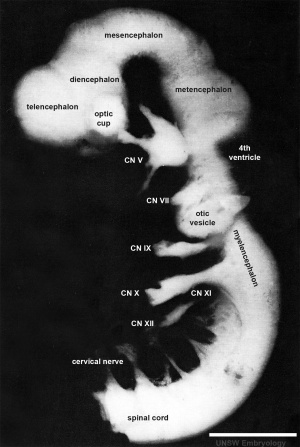
| The cranial nerves (ganglia) are represented by a roman numeral (I - XII) and many have additional historic names. They are paired, and can be mixed (motor/sensory), and the brain equivalent of the spinal cord spinal nerves.
In embryonic development, the trigeminal ganglia (CN V, historically the semilunar ganglion, Gasser's ganglion or Gasserian ganglion) is the first to become apparent and is the largest of the cranial nerves. Neural development is one of the earliest systems to begin and the last to be completed after birth. This development generates the most complex structure within the embryo and the long time period of development means in utero insult during pregnancy may have consequences to development of the nervous system. Differences between birds and mammals:
Neural development beginnings quite early, therefore also look at notes covering Week 3- neural tube and Week 4-early nervous system. Development of the neural crest and sensory systems (hearing/vision/smell) are only introduced in these notes and are covered in other notes sections. |
| Cranial Nerves | |
|---|---|
| CN I | Olfactory |
| CN II | Optic |
| CN III | Oculomotor |
| CN IV | Trochlear |
| CN V | Trigeminal |
| CN VI | Abducent |
| CN VII | Facial |
| CN VIII | Acoustic |
| CN IX | Glossopharyngeal |
| CN X | Vagus |
| CN XI | Accessory |
| CN XII | Hypoglossal |
| Cranial Nerves | ||||
|---|---|---|---|---|
| Nerve Number | Name | Type | Origin | Function |
| CN I | Olfactory | sensory | telencephalon | smell placode |
| CN II | Optic | sensory | retinal ganglial cells | vision |
| CN III | Oculomotor | motor | anterior midbrain | extraocular muscles eye movements and pupil dilation (motor) |
| CN IV | Trochlear | motor | dorsal midbrain | extraocular muscles (superior oblique muscle) |
| CN V | Trigeminal | motor/sensory | pons | touch, mastication |
| CN VI | Abducent | motor | extraocular muscles | control eye movements (lateral rectus muscle) |
| CN VII | Facial | motor/sensory | pons | facial expression, taste (tongue anterior and central regions) regulate salivary production. |
| CN VIII | Acoustic | sensory | vestibular and cochlear nuclei | hearing, placode |
| CN IX | Glossopharyngeal | motor/sensory | medulla | swallowing and speech, taste (tongue posterior region) |
| CN X | Vagus | motor/sensory | medulla | larynx and pharynx muscles (speech and swallowing), regulates heartbeat, sweating, and peristalsis |
| CN XI | Accessory | motor | motor neurons | sternocleidomastoid and trapezius muscles |
| CN XII | Hypoglossal | motor | motor neurons | tongue muscles (speech, eating and other oral functions) |
| Cranial Nerve Links: Neural | Neural Crest | CN I | CN II | CN III| CN IV | CN V | CN VI | CN VII | CN VIII | CN IX | CN X | CN XI | CN XII | placodes | Category:Cranial Nerve |
Some Recent Findings
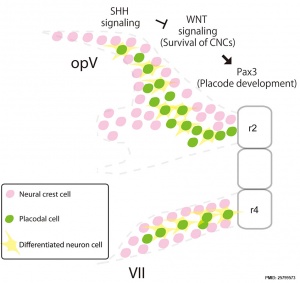
|
| More recent papers |
|---|
|
This table allows an automated computer search of the external PubMed database using the listed "Search term" text link.
More? References | Discussion Page | Journal Searches | 2019 References | 2020 References Search term: Cranial Nerve Development <pubmed limit=5>Cranial Nerve Development</pubmed> |
Neural Development Overview
Neuralation begins at the trilaminar embryo with formation of the notochord within the mesoderm that underlies the ectoderm and do not physically contribute to the nervous system, but is involved with patterning its initial formation. The central portion of the ectoderm then forms the neural plate that folds to form the neural tube, that will eventually form the entire central nervous system.
- Early developmental sequence: Epiblast - Ectoderm - Neural Plate - Neural groove and Neural Crest - Neural Tube and Neural Crest
| Neural Tube | Primary Vesicles | Secondary Vesicles | Adult Structures |
|---|---|---|---|
| week 3 | week 4 | week 5 | adult |
| prosencephalon (forebrain) | telencephalon | Rhinencephalon, Amygdala, hippocampus, cerebrum (cortex), hypothalamus, pituitary | Basal Ganglia, lateral ventricles | |
| diencephalon | epithalamus, thalamus, Subthalamus, pineal, posterior commissure, pretectum, third ventricle | ||
| mesencephalon (midbrain) | mesencephalon | tectum, Cerebral peduncle, cerebral aqueduct, pons | |
| rhombencephalon (hindbrain) | metencephalon | cerebellum | |
| myelencephalon | medulla oblongata, isthmus | ||
| spinal cord, pyramidal decussation, central canal | |||
Embryonic Development
| Cranial Nerve Development | |
|---|---|
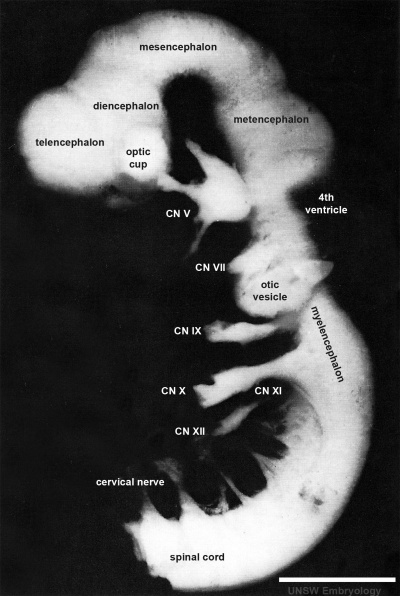
|
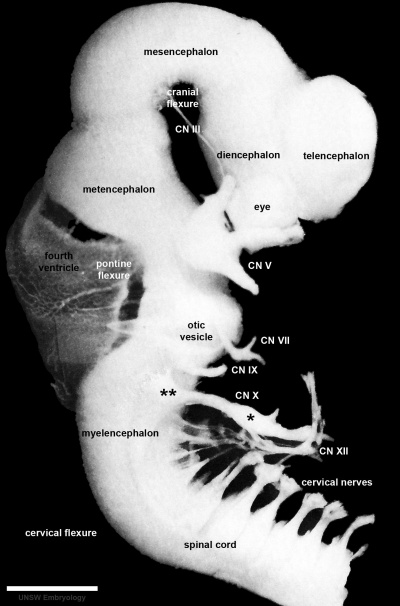
|
| stage 14 | stage 16 |
Size Growth
| Embryonic Central Nervous System | |||
|---|---|---|---|
| Stage 13 | Stage 14 | Stage 16 | Stage 21 |
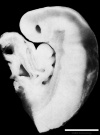
scale bar = 1 mm |
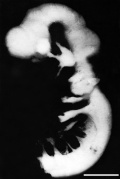
|
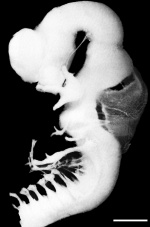
|
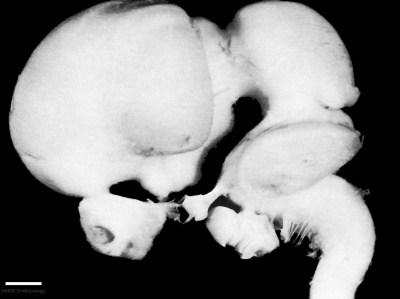
|
| Week 4 | Week 5 | Week 6 | Week 8 |
- Human CNS Images: Carnegie stage 13 | Carnegie stage 13 label | Carnegie stage 14 | Carnegie stage 14 label | Carnegie stage 16 | Carnegie stage 16 label | CN V | Carnegie stage 21 lateral | Carnegie stage 21 median | Fetus CRL 240mm | Neural System Development | Cranial Nerves
Motor and Sensory

|

|
| Cranial motor nerves brainstem nuclei of origin | Primary Terminal Nuclei of the Afferent (sensory) Cranial Nerves |
Pharyngeal Arches
During early development each pharyngeal arch is associated with different cranial nerves.
| Arch Nerve |
|---|
CN I Olfactory

Olfactory Nerve - Human fetus (Week 10) |
|
CN II Optic

Optic Nerve - Human embryo (week 8, Carnegie stage 22) |
|
CN III Oculomotor
motor - innervates muscles that enable most eye movement
development - oculomotor nerve is derived from the basal plate of the embryonic midbrain
- Links: vision
| Historic Embryology |
|---|
| Mann IC. The developing third nerve nucleus in human embryos (1927) J Anat. 61(4): 424-438. PubMed 17104156 |
CN IV Trochlear
motor - innervates the superior oblique muscle that enables eye movement
| Cranial Nerve | Rhombomere |
|---|---|
| trochlear | 1 |
| trigeminal | 2–3 |
| abducens | 5–6 |
| facial | 4–5 |
- Links: vision
CN V Trigeminal
(semilunar ganglion, Gasser's ganglion or Gasserian ganglion)
This is largest of all the cranial nerves during early development and has three major branches: ophthalmic nerve (V1), maxillary nerve (V2), mandibular nerve (V3)
mixed motor/sensory
- sensory - provide tactile, proprioceptive, and nociceptive afference to the face and mouth.
- motor - innervate the skin of the face via ophthalmic (V1), maxillary (V2) and mandibular (V3) divisions. Special visceral efferent (SVE) axons innervate the muscles of mastication via the mandibular (V3) division.
In the embryo, the trigeminal ganglia is first visible in week 4 stage 10, initially developing from neural crest cells before neural fold fusion, and after fusion receive contributions from the neural tube roof plate.[4]
In the adult, cavum trigeminale (Meckel's cave) is an arachnoidal pouch containing cerebrospinal fluid. Though the dura and arachnoid layers end at the trigeminal ganglion and do not extend to cover the three branches of the trigeminal nerve.[5]
Gasser's ganglion or Gasserian ganglion
This historic terminology was given by Antonius Hirsh who described the ganglion in 1765 and then named the ganglion in the honour of his teacher, Johann Lorenz Gasser (1723-1765) an Austrian anatomist.
CN VI Abducent
motor - innervates the lateral rectus muscle that enables eye movement
development - from the basal plate of the embryonic pons
- Links: vision
CN VII Facial
(N. Facialis; Seventh Nerve; CN VII)
Mixed motor/sensory
Development - second pharyngeal arch
|
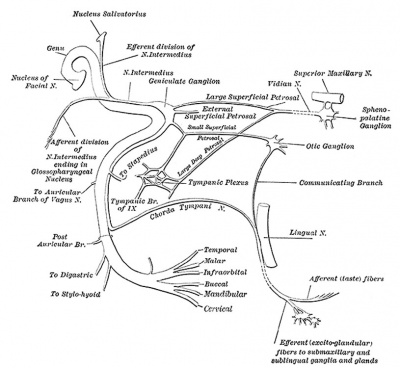
Gray Fig. 788. Plan of the Facial and Intermediate Nerves and their Communication with Other Nerves |
| The facial nerve (Figs. 788, 790) consists of a motor and a sensory part, the latter being frequently described under the name of the nervus intermedius (pars intermedii of Wrisberg) (Fig. 788). The two parts emerge at the lower border of the pons in the recess between the olive and the inferior peduncle, the motor part being the more medial, immediately to the lateral side of the sensory part is the acoustic nerve. |
Facial nerve development - right facial nerve and its nucleus of origin (A. 10 mm embryo, C. neonate).[6]
CN VIII Vestibulocochlear
Cranial nerve eight (CN VIII) In the embryo, cells derive from the otic placode forming the otic vesicle (otocyst). Ganglion previously thought to also involve otic neural crest (rhombomere 4)[4], but recent studies suggest an entirely placodal origin. In the adult, as in its name it consists of 2 parts vestibular (balance and position in space) and cochlear (hearing, spiral).
|
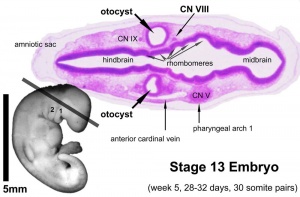
Embryo (week 5, Stage 13) showing inner ear and CNVIII. |
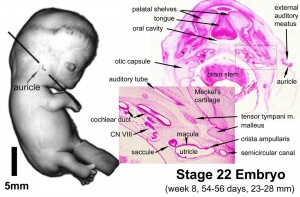
Embryo (week 8, Stage 2) showing otocyst and CNVIII. |

CN IX Glossopharyngeal
Mixed motor/sensory and lies anterior to the medulla oblongata
- Branchial motor (special visceral efferent) – supplies the stylopharyngeus muscle.
- Visceral motor (general visceral efferent) – provides parasympathetic innervation of the parotid gland via the otic ganglion.
- Visceral sensory (general visceral afferent) – carries visceral sensory information from the carotid sinus and carotid body.
General sensory (general somatic afferent) – provides general sensory information from inner surface of the tympanic membrane, upper pharynx (GVA), and the posterior one-third of the tongue.
Visceral afferent (special visceral afferent) – provides taste sensation from the posterior one-third of the tongue, including circumvallate papillae.
CN X Vagus
(pneumogastric nerve) responsible for heart rate, gastrointestinal peristalsis, sweating, and muscle movements in the mouth, including speech (via the recurrent laryngeal nerve)
Development
- motor derived from the basal plate of the medulla oblongata
- sensory derived from cranial neural crest
CN XI Accessory
motor - innervates the sternocleidomastoid and trapezius muscles
- sternomastoid - muscle superficial layer side of the neck, rotation of the head
- trapezius - superficial muscles from occipital bone to the lower thoracic vertebrae and laterally to the spine of the scapula, move the scapulae and support the arm
CN XII Hypoglossal
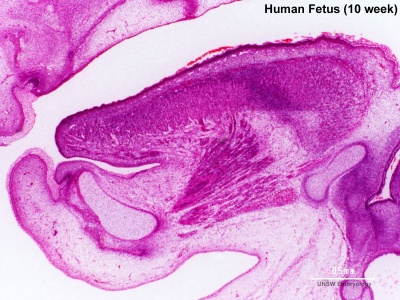
|
|
Neonatal - Clinical
Examination of the baby’s cranial nerve function is often accomplished by observing spontaneous activity.
| Newborn - Cranial Nerves | |||||||
|---|---|---|---|---|---|---|---|
|
| ||||||
| Normal | Abnormal |
Cranial Nerve Development: 3 months | 12 months | 18 months
- Links: Neural Exam Movies | Neonatal Development
Additional Images
Mouse E10.5 Nav2 expression[7]
Historic Images
| Historic Disclaimer - information about historic embryology pages |
|---|
| Pages where the terms "Historic" (textbooks, papers, people, recommendations) appear on this site, and sections within pages where this disclaimer appears, indicate that the content and scientific understanding are specific to the time of publication. This means that while some scientific descriptions are still accurate, the terminology and interpretation of the developmental mechanisms reflect the understanding at the time of original publication and those of the preceding periods, these terms, interpretations and recommendations may not reflect our current scientific understanding. (More? Embryology History | Historic Embryology Papers) |
Thyng FW. The anatomy of a 17.8 mm human embryo. (1914) Amer. J Anat. 17: 31-112. Harvard Collection
References
- ↑ 1.0 1.1 Kurosaka H, Trainor PA, Leroux-Berger M & Iulianella A. (2015). Cranial nerve development requires co-ordinated Shh and canonical Wnt signaling. PLoS ONE , 10, e0120821. PMID: 25799573 DOI.
- ↑ Simon E, Thézé N, Fédou S, Thiébaud P & Faucheux C. (2017). Vestigial-like 3 is a novel Ets1 interacting partner and regulates trigeminal nerve formation and cranial neural crest migration. Biol Open , 6, 1528-1540. PMID: 28870996 DOI.
- ↑ Sajgo S, Ali S, Popescu O & Badea TC. (2016). Dynamic expression of transcription factor Brn3b during mouse cranial nerve development. J. Comp. Neurol. , 524, 1033-61. PMID: 26356988 DOI.
- ↑ 4.0 4.1 O'Rahilly R & Müller F. (2007). The development of the neural crest in the human. J. Anat. , 211, 335-51. PMID: 17848161 DOI.
- ↑ Kehrli P, Maillot C & Wolff MJ. (1997). Anatomy and embryology of the trigeminal nerve and its branches in the parasellar area. Neurol. Res. , 19, 57-65. PMID: 9090638
- ↑ Streeter GL. The nuclei of origin of the cranial nerves in the 10 mm human embryo. (1908) Amer. J Anat. 2:111 - 115.
- ↑ 7.0 7.1 McNeill EM, Roos KP, Moechars D & Clagett-Dame M. (2010). Nav2 is necessary for cranial nerve development and blood pressure regulation. Neural Dev , 5, 6. PMID: 20184720 DOI.
Reviews
Greene ND & Copp AJ. (2009). Development of the vertebrate central nervous system: formation of the neural tube. Prenat. Diagn. , 29, 303-11. PMID: 19206138 DOI.
Barlow LA. (2002). Cranial nerve development: placodal neurons ride the crest. Curr. Biol. , 12, R171-3. PMID: 11882306
Articles
Saitsu H & Shiota K. (2008). Involvement of the axially condensed tail bud mesenchyme in normal and abnormal human posterior neural tube development. Congenit Anom (Kyoto) , 48, 1-6. PMID: 18230116 DOI.
Search PubMed
Search Pubmed: Tectum Embryology | Tectum Development
Glossary Links
- Glossary: A | B | C | D | E | F | G | H | I | J | K | L | M | N | O | P | Q | R | S | T | U | V | W | X | Y | Z | Numbers | Symbols | Term Link
Cite this page: Hill, M.A. (2024, April 24) Embryology Neural - Cranial Nerve Development. Retrieved from https://embryology.med.unsw.edu.au/embryology/index.php/Neural_-_Cranial_Nerve_Development
- © Dr Mark Hill 2024, UNSW Embryology ISBN: 978 0 7334 2609 4 - UNSW CRICOS Provider Code No. 00098G
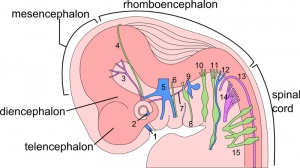


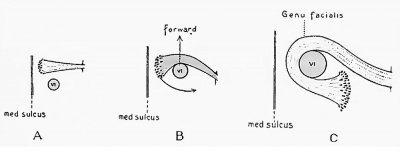


![Mouse E10.5 Nav2 expression[7]](/embryology/images/thumb/c/c4/Mouse_E10.5_Nav2_expression.jpg/120px-Mouse_E10.5_Nav2_expression.jpg)



